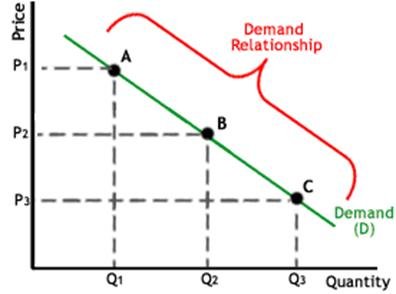Law of demand defines the relationship among the quantity demanded and price of a product.
It tells us that the demand for a product declines with rise in its price and vice versa, ceteris paribus (while other factors are at constant).
So, there is an inverse(opposite) relationship between the price and quantity demanded of a product.
“The greater the amount to be sold, the smaller must be the price at which it is offered in order that it may find purchasers; or in other words, the amount demanded increases with a fall in price and diminishes with a rise in priceâ€- Alfred Marshall.
Graph of Law of Demand:

Â
Definitions of law of demand given by different authors are:
Definition by Ferguson,
“Law of Demand, the quantity demanded varies inversely with price.â€
Definition by Robertson,
“Other things being equal, the lower the price at which a thing is offered, the more a man will be prepared to buy it.â€
Definition by Alfred Marshall,
“The greater the amount to be sold, the smaller must be the price at which it is offered in order that it may find purchasers; or in other words, the amount demanded increases with a fall in price and diminishes with a rise in price.â€
Demand is a dependent variable, whereas price is an independent variable.
Therefore, demand is a function of price and can be expressed as follows:
D = f(P) Where D= Demand, f = Functional Relationship, and P= Price
In law of demand, other factors of demand (excluding price) should be kept constant as the demand is subject to several influences. If all the influences would be allowed to vary at same time, this may counteract the law. Law of demand can be understood with the support of certain concepts, such as demand curve, demand schedule, and demand function.
February 18, 2017